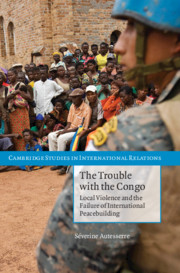Book contents
- Frontmatter
- Contents
- List of Figures and Tables
- Glossary of Acronyms, Names, and Ethnic Terms
- 1 Map of the Democratic Republic of the Congo and Its Neighbors
- Preface and Acknowledgments
- 1 The Peacebuilding World
- 2 A Top-Down Problem
- 3 A Top-Down Solution
- 4 A Bottom-Up Story
- 5 The Defeat of Bottom-Up Solutions
- 6 Beyond the Congo
- Appendix: Chronology
- Bibliography
- Index
- Cambridge Studies in International Relations
5 - The Defeat of Bottom-Up Solutions
Published online by Cambridge University Press: 05 June 2012
- Frontmatter
- Contents
- List of Figures and Tables
- Glossary of Acronyms, Names, and Ethnic Terms
- 1 Map of the Democratic Republic of the Congo and Its Neighbors
- Preface and Acknowledgments
- 1 The Peacebuilding World
- 2 A Top-Down Problem
- 3 A Top-Down Solution
- 4 A Bottom-Up Story
- 5 The Defeat of Bottom-Up Solutions
- 6 Beyond the Congo
- Appendix: Chronology
- Bibliography
- Index
- Cambridge Studies in International Relations
Summary
In 2007, I interviewed a high-ranking Western diplomat, who concluded our conversation with the statement:
I don't see this war, or most of the violence [during the transition], as being a question of conflict between communities in the Congo. Even in Ituri, the ethnic element of it was largely drummed up, provoked by politicians and leaders of groups who had a vested interest in power and the control of territories and of riches. There are some local conflicts that need to be resolved, certainly between Banyamulenge and the population in Bukavu [South Kivu], or between Tutsis and Hutus or Hundes in Masisi [North Kivu], but they are not the forces that perpetuate the chaos. The forces that keep the chaos going are the interests of various groups, both foreign and domestic [people in Uganda and Rwanda, Congolese intermediaries, Rwandan Hutu militias]….
[In the Congo,] there was never a conflict in the first place. The war started because the Congo was invaded, because [the Rwandan and Ugandan presidents] did not want Kabila anymore …. The Congolese were not fighting each other until Rwanda and Uganda … paid or forced them … to do it. … [Land conflict, conflict around traditional power, and so on] are all minor considerations in my view …. So I have to be very blunt about it, if I had $100 million, I would not spend [it] on local conflict resolution …. I am telling you straightforwardly that if you are looking at local conflicts as having more than a two percent influence on violence, you are in outer space.
- Type
- Chapter
- Information
- The Trouble with the CongoLocal Violence and the Failure of International Peacebuilding, pp. 179 - 230Publisher: Cambridge University PressPrint publication year: 2010

